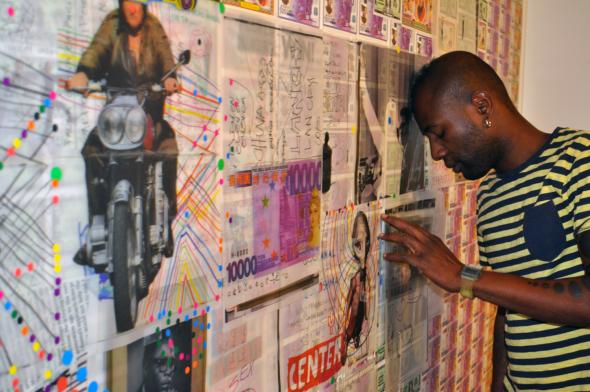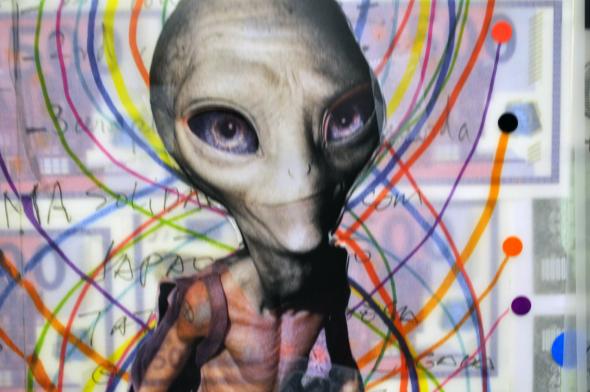Yonamine, from Luanda to the world
It was 1975, the year of independence and of the troubled process of decolonization, when Yonamine was born in Luanda. After wandering through Zaire and later spells in Brazil and England, he would return to his hometown, where his creative potential began to awake to art. He currently lives and works in Lisbon and Luanda, with several stays as a traveller artist in a sort of no man’s land, where the artistic vision of those he crosses his path with and his sensual references of real locations converge.
 Yonamine, 2011. Installation assemblage open studio Cité Internationale des Arts, Paris, France.
Yonamine, 2011. Installation assemblage open studio Cité Internationale des Arts, Paris, France.
Yonamine’s artistic training was driven since the First Trienal of Luanda, where he participated in several workshops, collective exhibitions and seminars: it was the beginning of an epic period of shows, biennial and triennial expos and artist residencies. Brazil, Cuba, Venice Biennale, Sharjah Biennial in the United Arab Emirates, Spain, New York, Australia and many other destinations would follow. With no time to digest what was happening to him, because of the urgency with which these artists have been asked to show the new Angolan art and along with his creative merits, the opportunities were to follow one another. The curiosity about his views on the city, his country, and the methodology of his work arouses, the irony of his proposals is appreciated, and his works are increasingly requested by gallerists. His deleted canvases, installations and videos where references emerge, and the mastery in the overlapping techniques boldly consolidated an ever-changing work, whose talent and contemporary language helped him climbing in the world of contemporary art. Painting, drawing, engraving, graffiti, photography, video and installation: the combination of registers and multiple languages is characteristic of Yonamine’s work, in an endless quest for expression.
The beginnings of his career were in the graphic arts, as he made t-shirts, logos and flyers. Familiar with this kind of immediate interaction, he cultivated a taste for transmitting and provoking questions over a sort of big screen visible to everyone. Thus the painting came as a vehicle of expression for understanding the society, as Angola is a country full of creative situations to the naked eye and Luanda, from the township to the Upper Town, is traversed by a strong creative energy. Taking account of traditional Angolan culture, which is rich in original features especially considering Lunda-Tchokwe culture, he uses ethnic symbols less like blasphemy than as provocation and even identification.
 Yonamine, 2011. Installation detail open studio Cité Internationale des Arts, Paris, France
Yonamine, 2011. Installation detail open studio Cité Internationale des Arts, Paris, France
The deconstruction of African stereotypes and the dialogue with western art in a process of transculturation that appropriates and recycles these traditions are characteristics of contemporary African art since the 1990s. But this new generation of artists has also brought the moment of Angolan euphoria, struggling with a strong international presence, a certain market interest and the political responsibility of showing the local context. Events such as the Luanda Trienal encouraged the Angolan artists to show other paths and boost the culture, and contributed also to their professionalization. Without having an institute of arts or contemporary art centre, or even an established formal art education, the public and the artists began to realise the existence of these new languages and of the international circuit, and now claim an important place for new generations of creators.
Yonamine is very spontaneous in his work: he thinks about pictures or objects, old photographs, cigarettes packs, or curious textures, then follows their trail to create, to subvert certain applications and to give them other semiotic readings, by reinventing the fragments of different memories in a register of composed intelligibility. Conflict and unpredictability abound in his work and it’s this not classifiable side that troubles, in a good way, who watches it. You can immediately feel the urgency, and this may come largely from living in Angola.
This text was partially published in Austral magazine